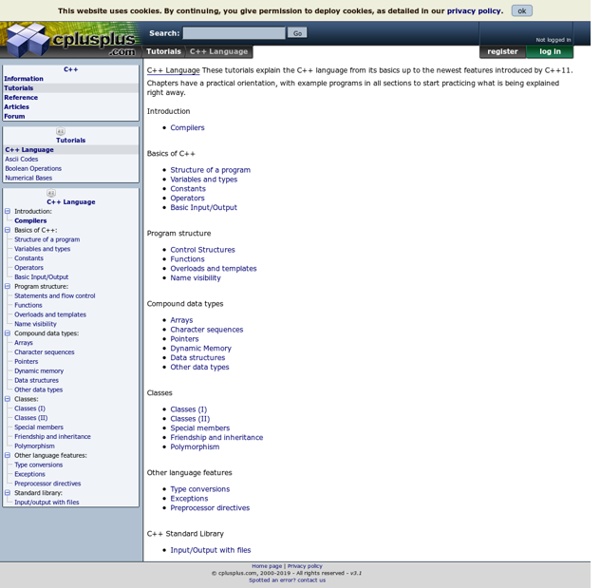Imagine++: Imagine++ Libraries - version 4.3.2
The most up to date version of this documentation should be on the website: Imagine++ is a set of libraries developed at the Imagine group ( Initially designed for students and beginners, and though it is still easy enough for them, Imagine++ is now used daily by Imagine researchers. It consists in different modules.
Abstract Class vs Interface
Introduction: There are lost of discussion on the internet about the Interface vs Abstract class. Also, as base class whether we have to use interface, abstract class or normal class. I am trying to point out few considerations on which we can take decision about Interface vs Abstract class vs Class.
C, C++ Programming Tutorials
Welcome! If you're new to C++, I recommend you purchase my ebook, Jumping into C++, a complete step-by-step guide for beginners. If you're looking for free tutorials, learn C++ with our C++ tutorial, starting at C++ Made Easy, Lesson 1 (all lessons) If you want to learn C instead, check out our C tutorial C Made Easy, Lesson 1 (all lessons) Want more advanced material on C, C++ graphics, game programming or algorithms?
Introduction to Make
Introduction to Make by Jennifer Vesperman 01/31/2002 Make originated as a system for building compiled code. It is now used as a system for making changes across many files and directories.
General Introduction
Page last changed today See chapter 1 of the book . JavaScript is supported by Mozilla (from Netscape 2), Explorer (from version 3), Opera (from version 3), Safari, iCab, and Konqueror.
C++ Interface Classes - An Introduction
Class hierarchies that have run-time polymorphism as one of their prominent characteristics are a common design feature in C++ programs, and with good design, it should not be necessary for users of a class to be concerned with its implementation details. One of the mechanisms for achieving this objective is the separation of a class's interface from its implementation. Some programming languages, e.g.
Build Your Own External Hard Drive
Step 1: Choose the right enclosure Many newer drives employ SATA, which uses a much smaller connector (above). Older IDE drives connect via two rows of pins (below). Consider two key factors when choosing an enclosure: size and interface. Size is easy: If the drive came from a desktop PC, it's probably a 3.5-inch model—though, if it dates from the late '90s, there's a small chance it could be 5.25-inch. Most notebooks, meanwhile, use 2.5-inch drives.
Google C++ Style Guide
Definition: Streams are a replacement for printf() and scanf(). Pros: With streams, you do not need to know the type of the object you are printing. You do not have problems with format strings not matching the argument list. (Though with gcc, you do not have that problem with printf either.)
Floating point
A diagram showing a representation of a decimal floating-point number using a mantissa and an exponent. In computing, floating point describes a method of representing an approximation of a real number in a way that can support a wide range of values. The numbers are, in general, represented approximately to a fixed number of significant digits (the significand) and scaled using an exponent. The base for the scaling is normally 2, 10 or 16.
The C++ Programming Language
The C++ Programming Language is a computer programming book first published in October 1985. It was the first book to describe the C++ programming language, written by the language's creator, Bjarne Stroustrup. In the absence of an official standard, the book served for several years as the de facto documentation for the evolving C++ language, until the release of the ISO/IEC 14882:1998: Programming Language C++ standard on 1 September 1998.
Templates
Overloading operators Classes, essentially, define new types to be used in C++ code. And types in C++ not only interact with code by means of constructions and assignments. They also interact by means of operators. For example, take the following operation on fundamental types:



